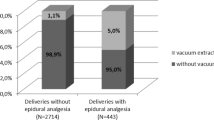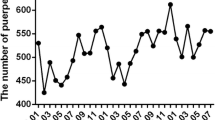Abstract
Objective is to examine the effect of epidural analgesia in first stage of labor on occurrence of cesarean and operative vaginal deliveries in nulliparous women and multiparous women without a previous cesarean delivery. Design of the Prospective cohort study. Prenatal care was received at 12 free-standing health centers, 7 private physician offices, or 2 hospital-based clinics; babies were delivered at a free standing birth center or at 3 hospitals, all in San Diego, CA. This study of 2,052 women used data from the San Diego Birth Center Study that enrolled women between 1994 and 1996 to compare the birthing management of the collaborative Certified Nurse Midwife-Medical Doctor Model with that of the traditional Medical Doctor Model. Main Outcome Measures of the Cesarean or operative vaginal deliveries. After adjusting for differences between women who used and those who did not use epidural analgesia in 1st stage of labor, epidural use was associated with a 2.5 relative risk (95% CI: 1.8, 3.4) for operative vaginal delivery in nulliparous women, and a 5.9 relative risk (95% CI: 3.2, 11.1) in multiparous women. Epidural use was associated with a 2.4 relative risk (95% CI: 1.5, 3.7) for cesarean delivery in nulliparous women, and a 1.8 relative risk (95% CI: 0.6, 5.3) in multiparous women. Epidural anesthesia increases the risk for operative vaginal deliveries in both nulliparous and multiparous women, and increases risk for cesarean deliveries in nulliparous more so than in multiparous women.
Similar content being viewed by others
References
ACOG Committee Opinion: Analgesia and cesarean delivery rates. (2006). Obstet gynecol, 107(6), 1487-8.
Thorp, J. A., Parisi, V. M., Boylan, M. B., & Johnston, D. A. (1989). The effect of continuous epidural analgesia on cesarean section for dystocia in nulliparous women. American Journal of Obstetrics and Gynecology, 161, 670–675.
Sharma, S. K., McIntire, D. D., Wiley, J., & Leveno, K. J. (2004). Labor analgesia and cesarean delivery. Anesthesiology, 100, 142–148.
Wong, C. A., Scavone, B. M., Peaceman, A. M., et al. (2005). The risk of cesarean delivery with neuraxial analgesia given early versus late in labor. New England Journal of Medicine, 352(7), 655–665.
Rothman, K. J. (1977). Epidemiologic methods in clinical trials. Cancer, 39, 1771–1775.
Swartz, W., Jackson, D., Lang, J., et al. (1998). The birthplace collaborative practice model: Results from the San Diego birth center study. Primary care update for Ob/Gyns, 5(4), 207.
Swartz, W. H. (1999). Final report: A prospective study of an out-of-hospital birth center. Washington DC/San Diego: Agency for Health Care Policy and Research/Primary Care Perinatal Services.
Jackson, D. J., Lang, J. M., Dickinson, C., et al. (1994). Use of the nurse-midwifery clinical dataset for classification of subjects in birth center research. Journal of Nurse-Midwifery, 39(4), 197–213.
Lieberman, E., Lang, J. M., Cohen, A., et al. (1996). Association of epidural analgesia with cesarean delivery in nulliparas. Obstetrics and Gynecology, 88(6), 993–1000.
Yuan, Y.C. (2000). Multiple imputation for missing data: concepts and new development. In: Proceedings of the twenty-fifth annual SAS users group international conference. SAS institute, Paper No. 267. Available at: http://support.sas.com/rnd/app/papers/multipleimputation.pdf.
Von Hippel, P. T. (2005). How many imputations are needed? A comment on Hershberger and Fisher (2003). Structural Equation Modeling, 12(2), 334–335.
Norton, N. J., Lipsitz, S. R., & Parzen, M. (2003). A Potential for bias when rounding in multiple imputation. American Statistician, 57(4), 229–232.
Schafer, J. L., & Olsen, M. K. (1998). Multiple imputation for multivariate missing-data problems: a data analyst’s perspective. Multivariate Behavioral Research, 33(4), 545–571.
Camann, W. (2005). Pain Relief during labor. New England Journal of Medicine, 352(7), 718–720.
D’Agostino, R. B., Jr. (1998). Propensity score method for bias reduction in the comparison of a treatment to a non-randomized control group. Statistics in medicine, 17, 2265–2281.
Cepeda, M. S., Boston, R., Farrar, J. T., et al. (2003). Comparison of logistic regression versus propensity score when the number of events is low and there are multiple confounders. American Journal of Epidemiology, 158, 280–287.
Hernan, M. A., Hernandez-Diaz, S., Werler, M. M., et al. (2002). Causal knowledge as a prerequisite for confounding evaluation an application to birth defects epidemiology. American Journal of Epidemiology, 155, 176–184.
Brookhart, M. A., Schneeweiss, S., Rothman, K. J., et al. (2006). Variable selection for propensity score models. American Journal of Epidemiology, 163, 1149–1156.
Jackson, D. J., Lang, J. M., Ecker, J., et al. (2003). Impact of collaborative management and early admission in labor on method of delivery. Journal of Obstetric, Gynecologic, and Neonatal Nursing, 32, 147–157.
Rothman, K. J., & Greenland, S. (1998). Introduction to stratified analysis. In K. J. Rothman & S. Greenland (Eds.), Modern epidemiology (2nd ed., pp. 253–300). Philadelphia, PA: Lippincott–Raven.
Rothman, K. J. (2002). Episheet. Available at: http://www.ken.rothman.name.
Sharma, S. K., Alexander, J. M., Messick, G., et al. (2002). Cesarean delivery a randomized trial of epidural analgesia versus intravenous meperidine analgesia during labor in nulliparous women. Anesthesiology, 96, 546–551.
Thorp, J. A., Hu, D. H., Albin, R. M., et al. (1993). The effect of intrapartum epidural analgesia on nulliparous labor: A randomized, controlled, prospective trial. American Journal of Obstetrics and Gynecology, 169(4), 851–858.
Zhang, J., Yancey, M. K., Klebanoff, M. A., Schwarz, J., & Schweitzer, D. (2001). Does epidural analgesia prolong labor and increase risk of cesarean delivery? A natural experiment. American Journal of Obstetrics and Gynecology, 185, 128–134.
Lieberman, E. (2004). Epidemiology of epidural analgesia and cesarean delivery. Clinical Obstetrics and Gynecology, 47(2), 317–331.
Rothman, K. J., & Greenland, S. (1998). Precision and validity in epidemiologic studies. In K. J. Rothman & S. Greenland (Eds.), Modern Epidemiology (2nd ed., pp. 115–134). Philadelphia, PA: Lippincott–Raven.
Klein, M. C. (2006). Does epidural analgesia increase rate of cesarean section? Canadian Family Physician, 52, 419–421.
Declercq, E., & Chalmers, B. (2008). Mothers’ reports of their maternity experiences in the USA and Canada. Journal of Reproductive and Infant Psychology, 26(4), 295–308.
Menacker, F., Declercq, E., & Macdorman, M. F. (2006). Cesarean delivery: background, trends and epidemiology. Seminars in Perinatology, 30(5), 235–241.
Witt, H. Latinos still the largest, fastest-growing minority, census shows. Los Angeles Times May 1 2008. Available at: http://www.latimes.com/news/nationworld/nation/la-na-census1-2008may01,1,3417355,print.story.
Statistical Portrait of Hispanics in the United States. (2006). Pew Hispanic Center Tabulation of 2006 American Community Survey (1% IPUMS). Available at: http://pewhispanic.org/files/factsheets/hispanics2006/Table-10.pdf. Accessed May 22, 2008.
Kurth, T., Walker, A. M., Glynn, R. J., et al. (2005). Results of multivariable logistic regression, propensity matching, propensity adjustment, and propensity-based weighting under conditions of nonuniform effect. American Journal of Epidemiology, 163, 262–270.
Soledad Cepeda, M., Boston, R., Farrar, J. T., et al. (2003). Comparison of logistic regression versus propensity score when the number of events is low and there are multiple confounders. American Journal of Epidemiology, 158, 280–287.
Acknowledgments
Sincere appreciation goes to William H. Swartz, MD, and the participants of the SDBCS for their time and dedication; and to Marian T. Hannan, DSc, MPH, and Judith T. Fullerton, PhD, CNM, FACNM, for their generous support and review of this manuscript.
Author information
Authors and Affiliations
Corresponding author
Rights and permissions
About this article
Cite this article
Nguyen, US.D.T., Rothman, K.J., Demissie, S. et al. Epidural Analgesia and Risks of Cesarean and Operative Vaginal Deliveries in Nulliparous and Multiparous Women. Matern Child Health J 14, 705–712 (2010). https://doi.org/10.1007/s10995-009-0515-9
Published:
Issue Date:
DOI: https://doi.org/10.1007/s10995-009-0515-9




